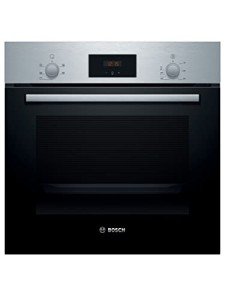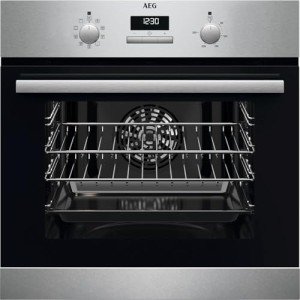
Single Fan Ovens
Add a reviewOverview
-
Founded Date May 22, 2011
-
Sectors AgriFood
-
Posted Jobs 0
-
Viewed 19
Company Description
The Secret Secrets Of Single Fan Oven

Understanding Single Fan Ovens: A Comprehensive Guide
Intro
As contemporary kitchen areas grow increasingly sophisticated, appliances developed for efficiency and efficiency are at the leading edge of customer interest. One such appliance that remains popular amongst home cooks and baking enthusiasts is the single fan oven, an electric model understood for its adaptability and ease of use. This article supplies thorough details about single fan ovens, including their performance, advantages, types, and considerations for purchase.
What is a Single Fan Oven?
A single fan oven, also referred to as a stove, features a single cooking chamber with a fan and exhaust system that flows hot air uniformly throughout the cooking area. This leads to an even cooking temperature and boosted cooking efficiency compared to standard fixed ovens.
Secret Components of a Single Fan Oven
- Heating Elements: Usually situated on top and bottom, these create heat for cooking.
- Fan: The central feature that circulates the hot air within the oven, promoting faster and more even cooking.
- Thermostat: Regulates the temperature level to guarantee optimal cooking conditions.
- Control Panel: Provides interface options for setting temperature levels, cooking times, and modes.
How Does a Single Fan Oven Work?
Single fan ovens run by integrating the heat from the heating elements with the air movement created by the fan. The hot air is distributed uniformly around the food, considerably reducing cooking time while also permitting for lower cooking temperatures.
Advantages of Using a Single Fan Oven
- Faster Cooking Times: The flowing air allows food to prepare faster compared to conventional ovens.
- Even Cooking: Food is exposed to consistent heat from all sides, lowering the possibilities of uneven cooking or locations.
- Flexibility: These ovens can be used for baking, roasting, and even barbecuing, making them suitable for a large range of dishes.
- Energy Efficiency: By cooking at lower temperatures and in less time, these ovens may utilize less energy than their conventional counterparts.
- Moisture Retention: The design assists keep moisture in dishes, leading to juicy roasts and baked items with a light texture.
Types of Single Fan Ovens
When thinking about a single fan oven, customers might encounter different types based upon functions and style. Here are a couple of common types:
1. Built-in Single Fan Ovens
- Description: Integrated into kitchen cabinets for a smooth look.
- Pros: Saves counter space, visually pleasing.
- Cons: Higher installation costs, may need expert assistance.
2. Freestanding Single Fan Ovens
- Description: Standalone units that can be positioned throughout the kitchen.
- Pros: Easy to install, flexible positioning.
- Cons: Can take up more area, may not mix well with cabinets.
3. Range Cookers with Fan Ovens
- Description: Multiple cooking choices, consisting of a fan oven, combined in one unit.
- Pros: Offers different cooking methods, ideal for enthusiastic cooks.
- Cons: Generally more expensive, larger footprint.
Contrast Table of Single Fan Oven Types
| Type | Pros | Cons |
|---|---|---|
| Built-in | Space-saving, visually pleasing | Greater expenses, expert installation required |
| Freestanding | Flexible placement | Takes up more area, might not match cabinets |
| Range Cooker | Several cooking methods | Higher price, larger size |
Choosing the Right Single Fan Oven
When choosing on a single fan oven, a number of factors need to be considered to guarantee that it meets individual cooking needs and fits within your kitchen design.
Aspects to Consider
- Size and Capacity: The size should match your kitchen layout while using sufficient capacity for your cooking practices.
- Functions and Functions: Look for adjustable racks, self-cleaning options, and several cooking modes to enhance flexibility.
- Energy Efficiency: Check for energy rankings; some designs are designed to be especially energy-efficient.
- Budget: Costs can vary significantly, making it important to develop a sensible spending plan in advance.
Upkeep Tips for Single Fan Ovens
- Routine Cleaning: Wipe down interior surfaces after use to prevent residue accumulation.
- Check the Fan: Ensure the fan is devoid of obstructions and functioning properly.
- Inspect Seals: Regularly examine the door seals for wear and tear to keep cooking performance.
- Professional Servicing: Schedule routine expert checks to make sure ideal operation.
FAQs about Single Fan Ovens
1. Can I utilize my single fan oven for baking?
Absolutely! Single fan ovens are outstanding for baking, offering consistent temperatures essential for cakes, cookies, and breads.
2. Is it essential to pre-heat a single fan oven?
While preheating is typically recommended for ideal outcomes, due to the efficiency of a fan oven, some dishes may not need it.
3. Can I cook multiple dishes simultaneously?
Yes! The even heat circulation in single fan Ovens & Hobs allows you to bake or roast numerous meals all at once, using all rack levels efficiently.

4. Does a single fan oven cook much faster than a conventional oven?
Yes, the fan-assisted heating decreases cooking times, making it possible for faster cooking.
Single fan ovens offer an extraordinary balance of speed, flexibility, and effectiveness, making them an important addition to any kitchen. Whether for baking, roasting, or everyday cooking, these ovens make sure that home cooks can produce tasty meals with ease. By comprehending the advantages, types, and factors to consider for buying a single fan oven, consumers can make an educated choice that aligns with their culinary desires and kitchen dynamics.
Accepting the functionalities of a single fan oven unquestionably leads the way for boosted cooking experiences in the modern kitchen.


